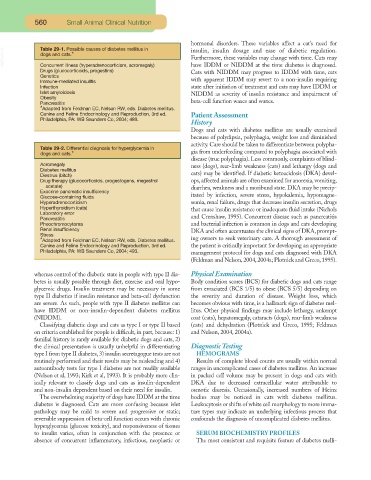Page 541 - Small Animal Clinical Nutrition 5th Edition
P. 541
560 Small Animal Clinical Nutrition
hormonal disorders. These variables affect a cat’s need for
Table 29-1. Possible causes of diabetes mellitus in
VetBooks.ir dogs and cats.* insulin, insulin dosage and ease of diabetic regulation.
Furthermore, these variables may change with time. Cats may
Concurrent illness (hyperadrenocorticism, acromegaly)
Drugs (glucocorticoids, progestins) have IDDM or NIDDM at the time diabetes is diagnosed.
Cats with NIDDM may progress to IDDM with time, cats
Genetics
Immune-mediated insulitis with apparent IDDM may revert to a non-insulin requiring
Infection state after initiation of treatment and cats may have IDDM or
Islet amyloidosis NIDDM as severity of insulin resistance and impairment of
Obesity
Pancreatitis beta-cell function waxes and wanes.
*Adapted from Feldman EC, Nelson RW, eds. Diabetes mellitus.
Canine and Feline Endocrinology and Reproduction, 3rd ed. Patient Assessment
Philadelphia, PA: WB Saunders Co, 2004; 489.
History
Dogs and cats with diabetes mellitus are usually examined
because of polydipsia, polyphagia, weight loss and diminished
activity. Care should be taken to differentiate between polypha-
Table 29-2. Differential diagnosis for hyperglycemia in
dogs and cats.* gia from underfeeding compared to polyphagia associated with
disease (true polyphagia). Less commonly, complaints of blind-
Acromegaly ness (dogs), rear-limb weakness (cats) and lethargy (dogs and
Diabetes mellitus
Diestrus (bitch) cats) may be identified. If diabetic ketoacidosis (DKA) devel-
Drug therapy (glucocorticoids, progestogens, megestrol ops, affected animals are often examined for anorexia, vomiting,
acetate) diarrhea, weakness and a moribund state. DKA may be precip-
Exocrine pancreatic insufficiency
Glucose-containing fluids itated by infection, severe stress, hypokalemia, hypomagne-
Hyperadrenocorticism semia, renal failure, drugs that decrease insulin secretion, drugs
Hyperthyroidism (cats) that cause insulin resistance or inadequate fluid intake (Nichols
Laboratory error
Pancreatitis and Crenshaw, 1995). Concurrent disease such as pancreatitis
Pheochromocytoma and bacterial infection is common in dogs and cats developing
Renal insufficiency DKA and often accentuates the clinical signs of DKA, prompt-
Stress
*Adapted from Feldman EC, Nelson RW, eds. Diabetes mellitus. ing owners to seek veterinary care. A thorough assessment of
Canine and Feline Endocrinology and Reproduction, 3rd ed. the patient is critically important for developing an appropriate
Philadelphia, PA: WB Saunders Co, 2004; 493. management protocol for dogs and cats diagnosed with DKA
(Feldman and Nelson, 2004, 2004a; Plotnick and Greco, 1995).
whereas control of the diabetic state in people with type II dia- Physical Examination
betes is usually possible through diet, exercise and oral hypo- Body condition scores (BCS) for diabetic dogs and cats range
glycemic drugs. Insulin treatment may be necessary in some from emaciated (BCS 1/5) to obese (BCS 5/5) depending on
type II diabetics if insulin resistance and beta-cell dysfunction the severity and duration of disease. Weight loss, which
are severe. As such, people with type II diabetes mellitus can becomes obvious with time, is a hallmark sign of diabetes mel-
have IDDM or non-insulin-dependent diabetes mellitus litus. Other physical findings may include lethargy, unkempt
(NIDDM). coat (cats), hepatomegaly, cataracts (dogs), rear-limb weakness
Classifying diabetic dogs and cats as type I or type II based (cats) and dehydration (Plotnick and Greco, 1995; Feldman
on criteria established for people is difficult, in part, because: 1) and Nelson, 2004, 2004a).
familial history is rarely available for diabetic dogs and cats, 2)
the clinical presentation is usually unhelpful in differentiating Diagnostic Testing
type I from type II diabetes,3) insulin secretagogue tests are not HEMOGRAMS
routinely performed and their results may be misleading and 4) Results of complete blood counts are usually within normal
autoantibody tests for type I diabetes are not readily available ranges in uncomplicated cases of diabetes mellitus. An increase
(Nelson et al, 1993; Kirk et al, 1993). It is probably more clin- in packed cell volume may be present in dogs and cats with
ically relevant to classify dogs and cats as insulin-dependent DKA due to decreased extracellular water attributable to
and non-insulin dependent based on their need for insulin. osmotic diuresis. Occasionally, increased numbers of Heinz
The overwhelming majority of dogs have IDDM at the time bodies may be noticed in cats with diabetes mellitus.
diabetes is diagnosed. Cats are more confusing because islet Leukocytosis or shifts of white cell morphology to more imma-
pathology may be mild to severe and progressive or static; ture types may indicate an underlying infectious process that
reversible suppression of beta-cell function occurs with chronic confounds the diagnosis of uncomplicated diabetes mellitus.
hyperglycemia (glucose toxicity), and responsiveness of tissues
to insulin varies, often in conjunction with the presence or SERUM BIOCHEMISTRY PROFILES
absence of concurrent inflammatory, infectious, neoplastic or The most consistent and requisite feature of diabetes melli-

